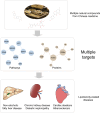Targeting lipid droplets and lipid droplet-associated proteins: a new perspective on natural compounds against metabolic diseases
- PMID: 39232826
- PMCID: PMC11373146
- DOI: 10.1186/s13020-024-00988-w
Targeting lipid droplets and lipid droplet-associated proteins: a new perspective on natural compounds against metabolic diseases
Abstract
Background: Lipid droplet (LD) is a metabolically active organelle, which changes dynamically with the metabolic state and energy requirements of cells. Proteins that either insert into the LD phospholipid monolayer or are present in the cytoplasm, playing a crucial role in lipid homeostasis and signaling regulation, are known as LD-associated proteins.
Methods: The keywords "lipid droplets" and "metabolic diseases" were used to obtain literature on LD metabolism and pathological mechanism. After searching databases including Scopus, OVID, Web of Science, and PubMed from 2013 to 2024 using terms like "lipid droplets", "lipid droplet-associated proteins", "fatty liver disease", "diabetes", "diabetic kidney disease", "obesity", "atherosclerosis", "hyperlipidemia", "natural drug monomers" and "natural compounds", the most common natural compounds were identified in about 954 articles. Eventually, a total of 91 studies of 10 natural compounds reporting in vitro or in vivo studies were refined and summarized.
Results: The most frequently used natural compounds include Berberine, Mangostin, Capsaicin, Caffeine, Genistein, Epigallocatechin-3-gallate, Chlorogenic acid, Betaine, Ginsenoside, Resveratrol. These natural compounds interact with LD-associated proteins and help ameliorate abnormal LDs in various metabolic diseases.
Conclusion: Natural compounds involved in the regulation of LDs and LD-associated proteins hold promise for treating metabolic diseases. Further research into these interactions may lead to new therapeutic applications.
Keywords: Lipid droplet; Lipid droplet-associated proteins; Metabolic diseases; Natural compounds.
© 2024. The Author(s).
Conflict of interest statement
The authors declare no competing interests.
Figures





Similar articles
-
Lipid droplet proteins and metabolic diseases.Biochim Biophys Acta Mol Basis Dis. 2018 May;1864(5 Pt B):1968-1983. doi: 10.1016/j.bbadis.2017.07.019. Epub 2017 Jul 21. Biochim Biophys Acta Mol Basis Dis. 2018. PMID: 28739173 Review.
-
Targeting of the Drosophila protein CG2254/Ldsdh1 to a subset of lipid droplets.J Cell Sci. 2017 Sep 15;130(18):3141-3157. doi: 10.1242/jcs.199661. Epub 2017 Aug 3. J Cell Sci. 2017. PMID: 28775149
-
CIDE family proteins control lipid homeostasis and the development of metabolic diseases.Traffic. 2020 Jan;21(1):94-105. doi: 10.1111/tra.12717. Traffic. 2020. PMID: 31746121 Review.
-
Protein Quality Control and Lipid Droplet Metabolism.Annu Rev Cell Dev Biol. 2020 Oct 6;36:115-139. doi: 10.1146/annurev-cellbio-031320-101827. Annu Rev Cell Dev Biol. 2020. PMID: 33021827 Free PMC article. Review.
-
Zeaxanthin remodels cytoplasmic lipid droplets via β3-adrenergic receptor signaling and enhances perilipin 5-mediated lipid droplet-mitochondrion interactions in adipocytes.Food Funct. 2022 Aug 30;13(17):8892-8906. doi: 10.1039/d2fo01094a. Food Funct. 2022. PMID: 35924967
Cited by
-
Natural anti-cancer products: insights from herbal medicine.Chin Med. 2025 Jun 9;20(1):82. doi: 10.1186/s13020-025-01124-y. Chin Med. 2025. PMID: 40490812 Free PMC article. Review.
-
Integrative Transcriptomics and Proteomics Analysis Reveals THRSP's Role in Lipid Metabolism.Genes (Basel). 2024 Nov 30;15(12):1562. doi: 10.3390/genes15121562. Genes (Basel). 2024. PMID: 39766829 Free PMC article.
-
N-Lactoyl-Phenylalanine modulates lipid metabolism in microglia/macrophage via the AMPK-PGC1α-PPARγ pathway to promote recovery in mice with spinal cord injury.J Neuroinflammation. 2025 Jun 27;22(1):167. doi: 10.1186/s12974-025-03495-3. J Neuroinflammation. 2025. PMID: 40579710 Free PMC article.
References
-
- Alferink LJM, Erler NS, de Knegt RJ, Janssen HLA, Metselaar HJ, Darwish Murad S, et al. Adherence to a plant-based, high-fibre dietary pattern is related to regression of non-alcoholic fatty liver disease in an elderly population. Eur J Epidemiol. 2020;35(11):1069–85. 10.1007/s10654-020-00627-2 - DOI - PMC - PubMed
-
- Fujimoto T. Lipid droplet as an independent organelle. Seikagaku. 2004;76(6):578–84. - PubMed
Publication types
Grants and funding
LinkOut - more resources
Full Text Sources
Research Materials

